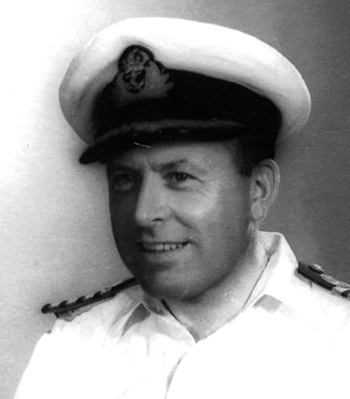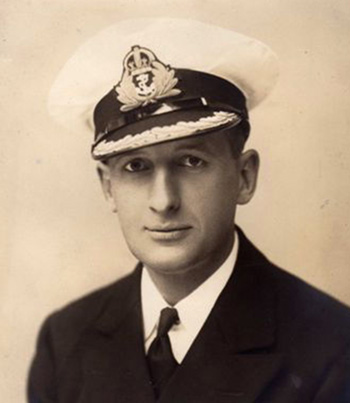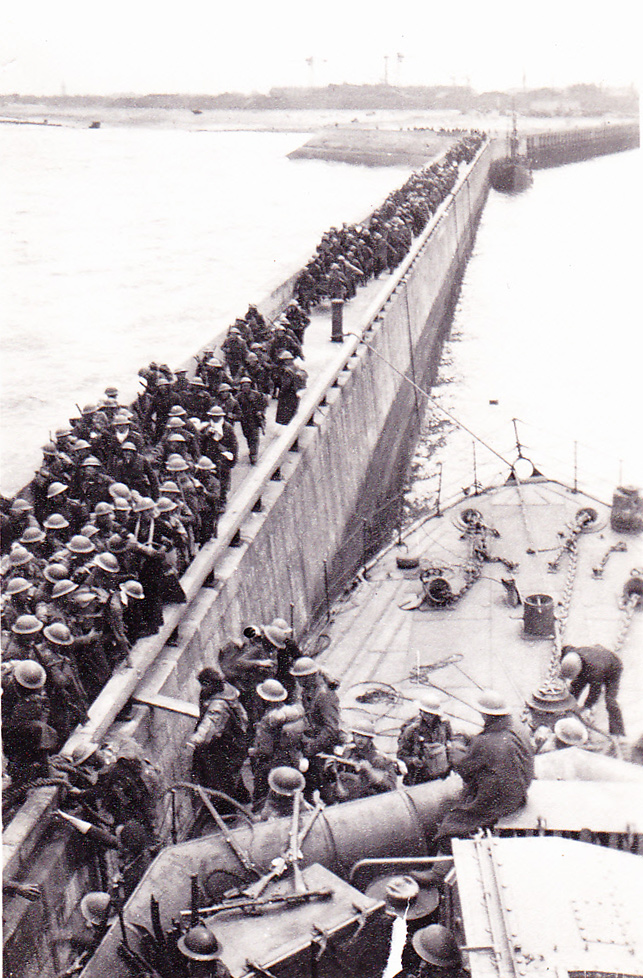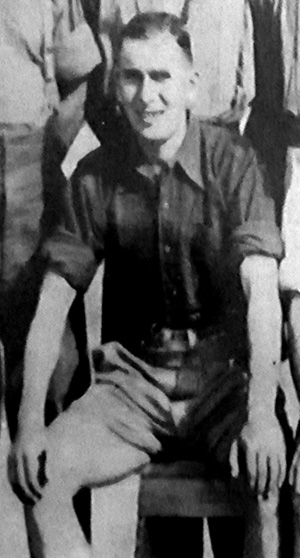






The Green Howards and the cordon at Dunkirk
Their escape aboard HMS Venomous on 2 - 3 June 1940

 Cdr Renfrew Gotto RN was part of Captain William Tennant's team of twelve officers and 160 ratings landed by HMS Wolfhound at Dunkirk on the 27 May to direct operations.
Cdr Renfrew Gotto RN was part of Captain William Tennant's team of twelve officers and 160 ratings landed by HMS Wolfhound at Dunkirk on the 27 May to direct operations.
Gotto (on left) had served as a Midshipman in HMS Venomous when she was first commissioned in 1919 and featured prominently in A Hard Fought Ship: the story of HMS Venomous (2017). Gotto and Brigadier R.H.R. Parminter,
the Deputy Quarter Master General of the BEF, were at the land end of
the East Mole and were responsible for controlling the troops waiting
to embark on the destroyers berthing alongside the Mole amongst which was his old ship, the Venomous.
Cdr J. Campbell Clouston RN,
a Canadian officer of Orkney descent was the Piermaster at the far end of
the East Mole, was killed on the evening of Sunday 2 June while
returning to Dunkirk from Dover and Commander Maund, Tennant's
assistant SNO, and Commander Gotto, filled in as piermasters.
It
took the the Green Howards nine hours to march the six miles from Bray
Dunes to Dunkirk on the night of the 1st June. Sgt L. F. Warn (4390283)
of the
5th Bn the Green Howards wrote an account of how the Green Howards
manned the cordon which controlled the troops waiting to embark on the
destroyers alongside the Mole on the night of 2 - 3 June and it was
published as "Venomous Encounter" in Hard Lying the magazine of the V & W Destroyer Association.
In
2009 I was able to contact Corporal Douglas King of the 5th Battalion's
D Company via the Regimental Museum of the Green Howards in Richmond,
Yorkshire, and he told me what he remembered of that night and a short
version of their stories featured in the previous edition of A Hard Fought Ship
in 2010. I have now been contacted by Mark Wilson the son of 96 year
old Private George Frederick Wilson of the Green Howards who was also
on the cordon at Dunkirk and I thought it would be appropriate to
combine their memories of that night and publish it in full on the
website. Sgt Lou Warn and Private George Wilson were in HQ Coy (Batallion HQ) and Corp Doug King was in D Coy.
Venomous was safe in harbour in the forenoon of 1 June when the Navy suffered its greatest losses and as she started her final approach to Dunkirk that afternoon the destroyers were ordered back to Dover. Ramsay had decided it was too dangerous to evacuate by day. Conditions on the beachhead and the Mole were chaotic when Venomous brought
back 1,100 troops that night and Sergeant Lou Warn, Corporal Doug King
and Private George Wilson describe the organising of a cordon to
control the embarkation on the 2nd June. The main narrative is by Sergeant Warn but the memories of Corporal King and Private Wilson are inserted and credited to them.
The cordon was very effective and when Venomous
left the Mole in the early hours of the 3rd June she had nearly 1,400
troops board including Capt Basil Dykes of the 7th Battalion of the
Worcestershire Regiment, the Green Howards and Generals Alexander and Percival.
The full
story of the part played by HMS Venomous in the evacuation of the BEF from Dunkirk is told in Chapter Six of the new hardback edition of A Hard Fought Ship published in May 2017.
**************

The beach at the coastal resort of Bray Dunes six miles east of the Mole at Dunkirk where HMS Venomous embarked the troops
This water damaged photograph was taken during the evacuation
Sergeant Lou Warn begins the story:
My encounter with HMS Venomous
was brief, dramatic and left a memory which will stay with me for the
rest of my life. To relate how she came into it I must go back to June
1940 when, as a Sergeant in the 3rd mortar platoon of the Fifth
Battalion the Green Howards, I arrived at Bray Dunes. This was about
half way between Dunkirk and La Panne. On the night of the 1st June at
about 10pm we started to move towards Dunkirk. The distance was about
six miles, and it took all night. We moved in pitch dark, in single
file, carrying our rifles and holding on to the man in front. Sometimes
in deep soft sand, sometimes up to our knees in the sea. Captain
Whittaker (later Sir J.M. Whittaker), who was wounded at Bray Dunes,
wrote in the 'Scarborough Evening News' some ten years later. "Those
who were there that night will never forget it, though many of them
were sleeping as they marched. Incidents that will long stay in their
memories."
Mark Wilson, the son of George Wilson who served throughout the war as a Private in the Green Howards tells his father's story:
His group dug in at
Bray Dunes & then marched to Dunkirk. It took them 9 hours to
traverse the dunes, overnight on 1st June. They arrived in Dunkirk on
the morning of 2nd June & went off the beach into seafront houses
to escape the Stukas. The weather was bad on 2nd June so there were no
dive bombers, but there was no respite as they were being shelled, so
they went out of the houses & on to the beach.
Sergeant Warn continues his account:
And so we came to the Mole, where chaos
and confusion reigned. Shells were falling, dive bombers screaming, and
then the words came down, "No more boats tonight, everybody back on the
beach." More chaos. All I remember is getting back onto the beach,
finding a hole in the sand and falling asleep. With daylight on the 2nd
the bombing and shelling started again. I left my hole and tried to
find other Green Howards. The Mole had been hit several times and there
seemed to be bodies everywhere. I found some Howards, and we eventually
came to the place where the C.O., Col. Bush, had set up his head
quarters.
 Right:
Right:
A photograph of the beach where the Green Howards formed their Cordon taken from HMS Wolsey on 30 May 1940 before the order was given that the destroyers should only operate at night.
Courtesy of Thomas Moore.
Corporal Doug King described how:
Sergeant Warn:
It was there that the officers and staff officer organised a bayonet cordon to police the embarkation that evening, and to prevent the chaos of the previous night. And so it was that I found myself one of a hundred other ranks and four officers controlling the embarkation. It is impossible to describe exactly what happened. There was a Major from the R.E's who seemed to appear from nowhere and who organised a rota. Somehow he found out the various groups and units and gave them all a time to embark. It seemed impossible, but it worked like a dream, and even the French troops co-operated.
Mark Wilson continues the story told to him by his father, Private George Wilson:
The four officers on
the cordon were drawn by lot, and as it happened the result was one
officer from each Company. They were: Capt. Bert Dennis of H.Q.
(Scarborough) Company, & Lieutenants Lishmund, Moor & Ramshaw
of A, B & C respectively. My father was at the far end of the
cordon and so was almost the last man to be evacuated. The cordon were all volunteers and
made up of single men; his brother in law also volunteered to stay with
him and be on it as well. My father told him to "Get on a bloody boat -
if I make it back & you don't, Wyn will kill me!" That was his
sister, my late Aunt Winifred, who was a very formidable woman right up
to her death aged 92. The expectation was that none of the men on the
cordon would be evacuated but they were, around midnight on 2nd June /1
a.m on 3rd June.
Sergeant Warn:
So well did our
cordon work that, just after midnight, we were told that all British
troops had passed through the cordon onto the Mole, and had been picked
up by the Naval boats waiting in the dark. We were told that there was
also a chance that we could also get away, and we should proceed to the
Mole at once as there was a destroyer ready to pick us up. The Mole
itself had been badly damaged which made getting a hundred men along it
quickly and in the dark a very daunting task. I remember seeing the
shadowy shape of the destroyer at the side of the Mole, and thinking
'Thank God I've made it.'
However there was not time to think as two
crew members took charge of me and one said "Now Jump!" I jumped. It
was dark and seemed so very unreal as the deck seemed to come up to
meet me. Then another crew member told me to put my rifle on a pile of
others, and led me down to a mess deck. I did not know it at the time,
but I was on board HMS Venomous. Members of the crew came round with
pails of water, which was very welcome as we had not shaved, washed or
even eaten for several days. I could hear the engines, and gunfire, and
feel the motion of the ship, but I had no idea if we were at sea or
still at Dunkirk.
Eventually we left the mess deck and were amazed to see the White Cliffs of Dover. We were back home.
I do not know if Venomous went back, but many naval ships did, and 26,000 were evacuated that night. When on the 4th June records show that the 18th German army at last captured Dunkirk, some 40,000 French were taken prisoner. These were the men who had held out much longer than expected and helped to make the Operation Dynamo such a success. In all some 338,226 Allied troops, including 143,000 French, were evacuated from Dunkirk, on more than 800 ships of every size and kind. Losses were heavy, including nine destroyers. I am told that HMS Venomous survived to be sold and broken up in July 1947.
Sergeant Lou Warn
Corporal Doug King
Private George Wilson
 |
 |
